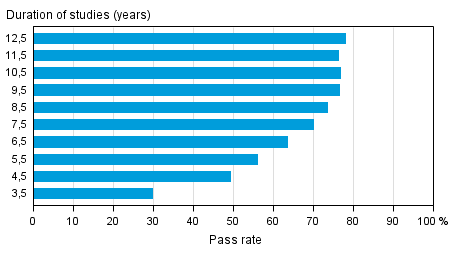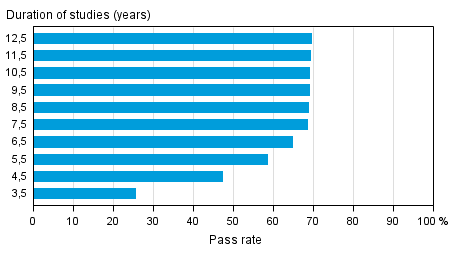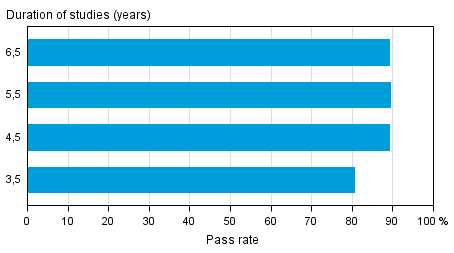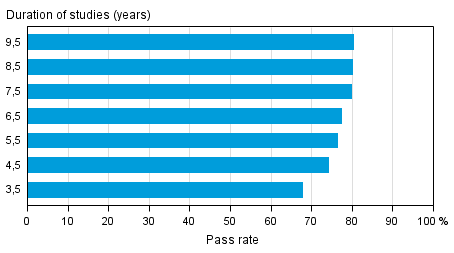Published: 17 March 2017
Qualifications were completed faster
According to Statistics Finland’s education statistics, completion of university education accelerated. In all, 56 per cent of the students having started university education completed their studies in five-and-a-half years, 33 per cent completed lower university level degrees and 23 per cent higher university degrees. The pass rates of university of applied sciences and upper secondary vocational education also improved in 2015.
Pass rates by sector of education in 2015 and 2014 1)
| Sector of education | Duration of studies (years) | Pass rate 2015 (%) | Pass rate 2014 (%) | Difference between pass rates in 2015–2014 |
| Upper secondary general education aimed at young people |
3,5 | 80,5 | 80,6 | -0,1 |
| Vocational education aimed at young people |
3,5 | 67,7 | 66,3 | 1,4 |
| University of applied sciences education (youth education) | 4,5 | 47,3 | 44,5 | 2,8 |
| University education (lower and higher university degrees) | 5,5 | 56,0 | 52,5 | 3,5 |
Pass rates for university education in different reference periods by the end of 2015 (lower and higher university degrees)

The pass rate of education grows, the longer time has passed from the start of education. The older the cohort of new students is examined, the higher the pass rate became. Seventy per cent of students completed a higher or lower university degree in seven-and-a-half years and, as many as 78 per cent of those having studied for 12.5 years have passed a university degree.
Pass rates of lower university degrees for young people in 2015 and 2014 by sex for those having studied for 3.5 to 4.5 years
| Sector of education | Duration of studies (years) | Gender | Pass rate 2015 (%) | Pass rate 2014 (%) | Difference between pass rates in 2015–2014 |
| University education (lower university degrees) | 3,5 | Men | 10,9 | 9,6 | 1,3 |
| Women | 21,9 | 20,5 | 1,4 | ||
| 4,5 | Men | 25,7 | 18,2 | 7,5 | |
| Women | 40,4 | 32,3 | 8,1 |
Only 17 per cent of those who had started studying for a lower university degree completed the lower university degree in the target time of three-and-a-half years. Female students completed a university degree in that time more often than men. Twenty-two per cent of women and 11 per cent of men completed a lower university degree. The difference in the pass rate was 11 percentage points. The pass rate at four-and-a-half years had improved by eight percentage points for both women and men in 2015 compared to the previous year.
Pass rates of higher university degrees for young people in 2015 and 2014 by sex for those having studied for 5.5 to 6.5 years
| Sector of education | Duration of studies (years) | Gender | Pass rate 2015 (%) | Pass rate 2014 (%) | Difference between pass rates in 2015–2014 |
| University education (higher university degrees) | 5,5 | Men | 18,4 | 18,0 | 0,4 |
| Women | 27,3 | 28,0 | -0,7 | ||
| 6,5 | Men | 28,6 | 28,0 | 0,6 | |
| Women | 42,7 | 40,6 | 2,1 |
Nearly one in four completed a higher university degree in the target time of five-and-a-half years. Female students completed a higher university degree in that time more often than men. Twenty-seven per cent of women and 18 per cent of men completed a higher university degree. The difference in the pass rate was nine percentage points. Among women that started studying for a university degree, 43 per cent completed the degree in six-and-a-half years and 29 per cent of men. The difference in the pass rate was 14 percentage points.
Over 60 per cent of women and close on one-third of men complete university of applied sciences degrees in the target time
Pass rates for university of applied sciences education in different reference periods by the end of 2015

Forty-seven per cent of those who started studying for a university of applied sciences degree completed their studies in four-and-a-half years. Education was completed in at most seven-and-a-half years by 69 per cent and in twelve-and-a-half years by nearly 70 per cent of those studying for a university of applied sciences degree. At its highest, the pass rate for university of applied sciences degrees was 74 per cent for those who started studying more than 13 years earlier.
Pass rates of university of applied sciences education for young people in 2015 and 2014 by sex for those having studied for 4.5 to 5.5 years
| Sector of education | Duration of studies (years) | Gender | Pass rate 2015 (%) | Pass rate 2014 (%) | Difference between pass rates in 2015–2014 |
| University of applied sciences education (youth education) | 4,5 | Men | 32,6 | 29,5 | 3,1 |
| Women | 60,3 | 57,7 | 2,6 | ||
| 5,5 | Men | 46,7 | 46,5 | 0,2 | |
| Women | 69,1 | 68,5 | 0,6 |
The difference between genders is even larger in the completion time of university of applied sciences education than in university education. Over 60 per cent of women completed their studies in four-and-a-half years, while close on one-third of men managed the same. The difference in the pass rate was 28 percentage points. Men close the gap a bit when five-and-a-half years of studies have passed. Sixty-nine per cent of women and 47 per cent of men had completed their studies in that time. The difference in the pass rate was 22 percentage points.
Completion of upper secondary general school in four years has increased slightly
Pass rates for upper secondary general education aimed at young people in different reference periods by the end of 2015

According to the data for 2015, upper secondary general education was completed typically in 3.5 to 4.5 years: Eighty-one per cent of new students in upper secondary general schools completed the upper secondary general school syllabus in at most three-and-a-half years and 89 per cent in at most four-and-a-half years. When the duration of studies was more than four-and-a-half years, the number of completers of upper secondary general education in relation to the number of those starting education settled between 89 and 90 per cent.
Pass rates of upper secondary general education aimed at young people in 2015 and 2014 by gender for those having studied for 3.5 to 4.5 years
| Sector of education | Duration of studies (years) | Gender | Pass rate 2015 (%) | Pass rate 2014 (%) | Difference between pass rates in 2015–2014 |
| Upper secondary general education
aimed at young people |
3,5 | Men | 80,1 | 79,9 | 0,2 |
| Women | 80,9 | 81,1 | -0,2 | ||
| 4,5 | Men | 88,0 | 87,5 | 0,5 | |
| Women | 90,2 | 89,6 | 0,6 |
Men studying in upper secondary general school passed their qualifications slightly slower than women studying there did. Eighty per cent of men completed their upper secondary general school qualification in three-and-a-half years, while for women, the corresponding figure was 81 per cent. Changes in the pass rate of upper secondary general education were small in 2015 compared to the previous year. The pass percentages of those who completed their education in four-and-a-half years grew by 0.5 percentage points for both men and women.
The pass rate of vocational education improved by 1.4 percentage points
Pass rates for vocational education aimed at young people in different reference periods by the end of 2015

The duration of qualifications completed in vocational education for young people varies more than that of upper secondary general qualifications. Sixty-eight per cent of vocational education students passed their vocational qualifications in three-and-a-half years or faster. Seventy-four per cent of students completed their education in at most four-and-a-half years.
The pass rate for vocational education grew yearly slightly also for those having studied longer: 76 per cent of those having started studies five-and-a-half years earlier and 80 per cent of those having started nine-and-a-half years earlier had completed their qualifications by the end of 2015.
Pass rates of vocational education aimed at young people in 2015 and 2014 by sex for those having studied for 3.5 to 4.5 years
| Sector of education | Duration of studies (years) | Gender | Pass rate 2015 (%) | Pass rate 2014 (%) | Difference between pass rates in 2015–2014 |
| Vocational education aimed at young people |
3,5 | Men | 67,4 | 66,7 | 0,7 |
| Women | 68,0 | 66,0 | 2,0 | ||
| 4,5 | Men | 73,9 | 73,1 | 0,8 | |
| Women | 74,1 | 73,0 | 1,1 |
Men and women completed their vocational education within the target time almost as often. Of women, 68 per cent completed their studies in three-and-a-half years and of men slightly more than 67 per cent. In four-and-a-half years, 74 per cent of both women and men had completed their studies.
When the duration of studies was over five-and-a-half years, women completed the qualifications they had started more often than men did. For women having started studies eight-and-a-half years ago, 81 per cent completed the vocational education by the end of 2015, while the respective figure for men was 79 per cent.
The database tables of these statistics contain information on the differences between the pass rates for different fields of sectors of education (see database tables). The database tables also include information on those students who did not attain their qualification in the target time.
In these statistics, the number of completers of education relative to starters of education has increased particularly for tertiary level education. Other statistics also indicate that studying was more interesting than in the year before, as both discontinuation of education and employment of students decreased (Discontinuation of education, Employment of students).
Source: Education Statistics, Statistics Finland
Inquiries: Anna Loukkola 029 551 3678, koulutustilastot@stat.fi
Director in charge: Jari Tarkoma
Publication in pdf-format (286.8 kB)
- Tables
-
Tables in databases
Pick the data you need into tables, view the data as graphs, or download the data for your use.
Appendix tables
- Appendix table 1. Progress of new upper secondary school students (aimed at young people) studies by end 2015 (17.3.2017)
- Appendix table 2. Progress of new students studies in vocational education (aimed at young people) by end 2015 (17.3.2017)
- Appendix table 3. Progress of new university of applied sciences students studies by end 2015, youth education (17.3.2017)
- Appendix table 4. Progress of new university students studies by end 2015, lower or higher university degrees (17.3.2017)
- Appendix table 5. Progress of new university students studies by end 2015, lower university degree (17.3.2017)
- Appendix table 6. Progress of new university students studies by end 2015, higher university degree (17.3.2017)
Updated 17.3.2017
Official Statistics of Finland (OSF):
Progress of studies [e-publication].
ISSN=1799-1021. 2015. Helsinki: Statistics Finland [referred: 25.12.2025].
Access method: http://stat.fi/til/opku/2015/opku_2015_2017-03-17_tie_001_en.html

